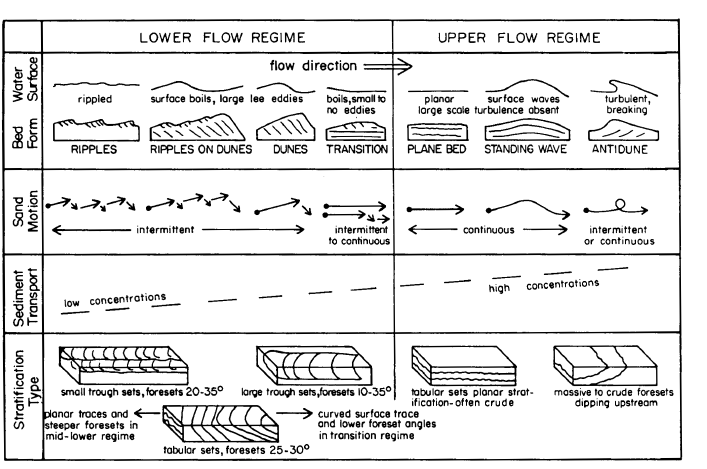Fluid Flow Regimes Review
Fluid Flow Table of Contents
Hydraulic and Pneumatic Knowledge
Fluid Flow Regimes Review
All fluid flow is classified into one of two broad categories or regimes. These two flow regimes are laminar flow and turbulent flow. The flow regime, whether laminar or turbulent, is important in the design and operation of any fluid system. The amount of fluid friction, which determines the amount of energy required to maintain the desired flow, depends upon the mode of flow. This is also an important consideration in certain applications that involve heat transfer to the fluid.
Flow regime relates bedforms in alluvial channels to flow velocity (Figure 1). The classification also shows the relationship between flow velocity and the mode of sediment transport, the concentration of sediment being transported and the phase relation between the bed and the water (water surface).
Flow regime can be broken down into three broad groupings: lower flow regime, transitional flow regime and upper flow regime.

Figure 1. Flow regime and its relationship to bed forms and other characteristics (Lewis, 1984)
Click on image to enlarge
Flow regime can be related to the Froude number which characterises whether flow will be tranquil or rapid. The Froude number is an expression of the ratio between the inertial (the force required to stop a moving particle) and gravitational forces.
where:
F = Froude number
V = velocity of the particle
g = acceleration due to gravity
L = the force of inertia, ie the length travelled by the particle before it comes to rest. This maybe substituted by h which = depth of flow.
The critical conditions are when F = 1 (transitional flow regime)
F < 1 - tranquil flow (lower flow regime) F > 1 - rapid flow (upper flow regime)
Note that although the equation predicts that you can move from lower to upper flow regime by either increasing velocity or decreasing water depth, flow velocities become too high if water depth is great. That is, velocities needed to produce upper flow regime conditions in water depths over a few metres are almost never found in nature. Rapid flow or upper flow regime is typically found where water depths range from a few millimetres to a few metres.
Although flow regime was developed for flow in alluvial channels, it is now applied to other subaqueous currents (eg turbidity currents).